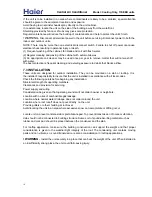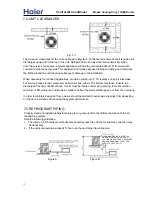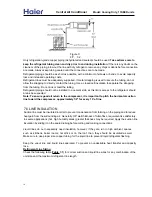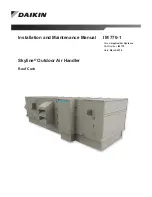
28
OPEN COMPRESSOR START WINDING--
-REPLACE THE COMPRESSOR .
7.The resistance from one winding terminal to any other terminal should be the same with three phase
compressors.
NOTE:
on larger 208/230 volt compressors the ohm values could be as low as 0.10 ohms,
THIS IS NOT A SHORTED WINDING .A winding is open if resistance measured is infinite(
).
Compressors fail mechanically due to bearing failure ,valve failure ,or damage to the internal suspension
SYSTEM PUMP DOWN
refrigerant as intended or if it leaks out.
Procedure
1.
on the compressor shell, or in the line between accumulator and compressor. Connect the high
2.
rises above 400 psi,
Shut off about outdoor unit.
COMPRESSOR MECHANICAL CHECKS
system. Bearing and valve failure is almost always caused by liquid refrigerant.
COMPRESSORS ARE
or breaking them. Liquid refrigerant also damages bearings by diluting or foaming the lubricating oil.
the liquid line service valve. The procedure uses the compressor to trap all the refrigerant inside the
DESIGNED TO ONLY PUMP REFRIGERANT VAPOR
. Liquid refrigerant damages the valves by deforming
This procedure tests the compressor valves. It can indicate internal refrigerant leaks such as through
condensing coil (outdoor cooling). The technician’s gauges indicate if the condensing coil holds the
Connect the compound refrigerant gauge to a service port that reads suction pressure such as
pressure gauge to a service port that reads high pressure .
POSITIVE PRESSURE. DO NOT OPERATE THE COMPRESSOR WITH A NEGATIVE SUCTION
suction pressure should fall. The high pressure should also fall slightly. If the discharge pressure
3. SHUT OFF THE COMPRESSOR WHEN THE SUCTION PRESSURE DROPS TO 3-5 PSI.
With the unit operating, front seat (close) the liquid line service valve. Observe the gauges .The
PRESSURE OR IN A VACUUM.
4.
Causes
:Leaking liquid line valve, leaking discharge check valve (scroll compressors only ),
Refrigerant is leaking from the
condenser coil .
Causes
:Leaking liquid line valve, leaking discharge check valve (scroll compressors only ),
leaking compressor valves.
ACTION
: Determine the causes and correct it..
This procedure checks the quality of the refrigerant by comparing the refrigerant pressure to its
SHUT Down the system when the suction pressure drops to 3-5 psi positive pressure .
2. Front SEAT THE LARGE VAPOR LINE VALVE.
MARK AND IDENTIFY THE WIRE TERMINALS
WITH THE COPRESPONDING WIRE COLOR CODE
WARNING :WRAP A LAYER OF INSULATION ELECTRICAL TAPE OVER THE WIRE TERMINALS ,
4.
After pump down and compressor stops, observe the suct
io
n pressure on the compound gauge.
A. The suction pressure holds as steady pressure.
this is a normal condition.
. Refrigerant is leaking from the condenser coil .
B. Suction pressure rises above the stopping point, but then stops and holds steady. Some refrigerant
ACTION
: Determine the causes and correct it.
finally evaporating in the coil, and registering on the gauge.
This is the normal condition.
C. Suction pressure conditions rise and eventually equalizes with the observed pressure on the high
leaking compressor valves.
Abnormal condition.
pressure guage.
D
. Unable to reach the 3-5 PSI level for suction pressure.
This is an abnormal condition.
SYSTEM REFRIGERANT NONCONDENSIBILES CHECK
temperature. The test tells if there are contaminating non-condensable gases in the refrigerant, usually
air or moisture.
1. Pump the system down as the explained in the previous procedure. Open the unit disconnect to
3. Disconnect the compressor by
REMOVING EACH WIRE FROM THE COMPRESSOR
TERMINALS.
(NOT THE COMPRESSOR TERMINALS) . THESE WIRE ENDS WILL BE AND GNERGISED HOT
DURING THE REMINDER OF THE TEST .
Close the disconnect switch to the system and run the condensing fan .Measure the condensing coil
Central Air Conditioner
Model: Cooling Only,
13
SEER
units

























